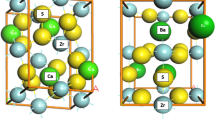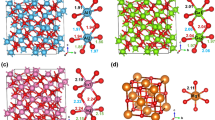Abstract
Titanium dioxide has received much attraction in the field of photocatalysts applied for hydrogen production from the water splitting due to its unique set of desirable properties of non-toxicity, chemical and thermal stability, efficient photocatalytic activity and low cost. However, it is only active under ultraviolet irradiation because of the wide band gap, which limits its photocatalytic efficiency. In the present paper, the geometrical structure, dopant formation energy, electronic structure and optical properties of a series of Zr–S co-doped anatase TiO2 were calculated by the GGA + U method based on density functional theory to narrow the band gap and expand its light absorption edge. The results show that the hybridization of O2p and S3p changes the energy levels near the top of valence band and Zr4d orbital makes a certain separation of the O2p and Ti3d orbital in conduction bands, which is helpful to prevent the recombination of electron and hole. The distance between S and Zr atom in the supercell has a significant influence on the electronic structure and optical properties of the co-doped system. The edge of co-doped TiO2 absorption band has a certain degree of redshift. This study may provide theoretical guidance for its application in photocatalysts.







Similar content being viewed by others
References
M.Z. Selcuk, M.S. Boroglu, I. Boz. Hydrogen production by photocatalytic water-splitting using nitrogen and metal co-doped TiO2 powder photocatalyst. React. Kinet. Mech. Catal. 2012, 106(2):313–324
C. Liu, Y. Song, X. Yu et al., Electronic structure and optical absorption spectra of C–Cr co-doped anatase TiO2 based on first principles. Physica Status Solidi, 2018:1700616
J. Li, S. Meng, L. Qin et al., Optical properties of anatase and rutile TiO2 studied by GGA + U. China Phys. B 26(8), 370–375 (2017)
H.X. Zhu, J.M. Liu, First principles calculations of electronic and optical properties of Mo and C co-doped anatase TiO2. Appl. Phys. A 117(2), 831–839 (2014)
J.I.G. Enriquez, J.L.V. Moreno, M.Y. David et al., DFT investigation on the electronic and water adsorption properties of pristine and N-doped TiO2, nanotubes for photocatalytic water splitting applications. J. Electron. Mater. 46, 1–11 (2017)
M. Ge, J. Cai, J. Iocozzia, et al. A review of TiO2 nanostructured catalysts for sustainable H2 generation. Int. J. Hydrogen Energy 42(12), 8418–8449 (2017)
T. Ohno, M. Akiyoshi, T. Umebayashi et al. Preparation of visible light active S-doped TiO2 photocatalysts and their photocatalytic activities. Water Sci. Technol. 2004, 49(4):159–163
D. Zhao, X. Huang, B. Tian et al., The effect of electronegative difference on the electronic structure and visible light photocatalytic activity of N-doped anatase TiO2 by first-principles calculations. Appl. Phys. Lett. 98(16), 269 (2011)
S. Cravanzola, F. Cesano, F. Gaziano, et al. Sulfur-dopedTiO2: Structure and surface properties. Catalysts 7(214), 1–11 (2017)
H.J. Yun, H. Lee, B.J. Ji et al., Tuning the band-gap energy of TiO2 – xCx nanoparticle for high performance photo-catalyst. Electrochem. Commun. 12(6), 769–772 (2010)
R. Asahi, T. Morikawa, T. Ohwaki et al., Visible-light photocatalysis in nitrogen-doped titanium oxides. Science 293(5528), 269–271 (2001)
W. Zeng, Q.J. Liu, Z.T. Liu, Structural, electronic and optical properties of S-doped anatase TiO2. Appl. Mech. Mater. 2015, 727–728:79–82
T. Umebayashi, T. Yamaki, H. Itoh et al., Band gap narrowing of titanium dioxide by sulfur doping. Appl. Phys. Lett. 81(3), 454–456 (2002)
F. Tian, C. Liu, DFT description on electronic structure and optical absorption properties of anionic S-doped anatase TiO2. J. Phys. Chem. B 110(36), 17866 (2006)
R. Liu, X. Zhou, F. Yang, et al. Combination study of DFT calculation and experiment for photocatalytic properties of S-doped anatase TiO2. Appl. Surf. Sci. 319(1), 50–59 (2014)
J.W. Pan, C. Li, Y.F. Zhao et al., Electronic properties of TiO2, doped with Sc, Y, La, Zr, Hf, V, Nb and Ta. Chem. Phys. Lett. 628, 43–48 (2015)
A. Juma, I.O. Acik, A. Oluwabi et al., Zirconium doped TiO2, thin films deposited by chemical spray pyrolysis. Appl. Surf. Sci. 387, 539–545 (2016)
A. Strini, A. Sanson, E. Mercadelli et al., In-situ anatase phase stabilization of titania photocatalyst by sintering in presence of Zr4+ organic salts. Appl. Surf. Sci. 347, 883–890 (2015)
J. Song, X. Wang, J. Yan, et al. Soft Zr-doped TiO2 nanofibrous membranes with enhanced photocatalytic activity for water purification. Sci. Rep. 7(1), 1–11 (2017)
T. Bigdeli, S.M. Dehaghi, The effect of trace amount of Zr-doped TiO2 on photocatalytic activity in degradation of organic waste. Energy Sources Part A Recovery Utilization Environ. Effects 40(3), 1–8 (2017)
A. Pasche, B. Grohe, S. Mittler et al., Zr-doped TiO2 nanoparticles synthesized via a sol-gel route and their application in dye-sensitized solar cells for thermo-stabilization. Mater. Res. Express, 2017, 4(6), 065501
L. Turner-Stokes, N. Sykes, E. Silber et al., Synthesis, characterization, and application of Zr, S Co-doped TiO2 as visible-light active photocatalyst. Bull. Korean Chem. Soc. 29(6), 1217–1223 (2008)
Q. Zhang, Y. Luo, Y. Li, et al. Preparation of TiO2 photocatalyst co-doped with Zr and S. Petrochem. Technol. 38(1), 15–19 (2009)
S. Zheng, G. Wu, L. Liu, et al. Electronic structure of Zr/S codoped anatase TiO2 calculated using first-principles. J. Ningxia Univ. 34(2), 132–140 (2013)
Y.U. Juan, T. Xia, X.U. Ming-Jie et al., The study of first-principles on the electronic and optical property of S and Zr Doped Anatase TiO2. J. Yili Normal Univ. 11(2), 32–36 (2017)
K. Yang, Y. Dai, B. Huang et al., First-principles GGA + U study of the different conducting properties in pentavalent-ion-doped anatase and rutile TiO2. J. Phys. D Appl. Phys. 47(47), 275101 (2014)
K. Yang, Y. Dai, B. Huang et al., Density-functional characterization of antiferromagnetism in oxygen-deficient anatase and rutile TiO2. Phys. Rev. B 81(3), 033202 (2010)
E. Finazzi, C.D. Valentin, G. Pacchioni et al., Excess electron states in reduced bulk anatase TiO2: Comparison of standard GGA, GGA + U, and hybrid DFT calculations. J. Chem. Phys. 129(15), 035108 (2008)
H.C. Wu, S.W. Lin, J.S. Wu, Effects of nitrogen concentration on N-doped anatase TiO2: density functional theory and Hubbard U, analysis. J. Alloys Compd. 522, 46–50 (2012)
D.X. Li, R.Q. Li, Y. Chen et al., Electronic structures and magnetism of rutile TiO2, with vacancy defects from first principles: GGA + U calculations. J. Supercond. Novel Magn. 30(1), 1–7 (2016)
Y.J. Zheng, H.U. Yi, T. Jing, et al. Calculations on the electronic structures of N-Al co doped anatase TiO2 by GGA + U methods. J. Mater. Sci. Eng. 33(6), 791–796 (2015)
Y. Furubayashi, T. Hitosugi, Y. Yamamoto, et al. A transparent metal: Nb-doped anatase TiO2. Appl. Phys. Lett. 86(25), 252101 (2005)
H. Kamisaka, T. Hitosugi, T. Suenaga, et al. Density functional theory based first-principle calculation of Nb-doped anatase TiO2 and its interactions with oxygen vacancies and interstitial oxygen. J. Chem. Phys. 131(3), 034702 (2009)
V. Çelik, E. Mete, Range-separated hybrid exchange-correlation functional analyses of anatase TiO2 doped with W, N, S, W/N, or W/S. Phys. Rev. B 86(20), 5890–5898 (2012)
Y. Wang, R. Zhang, J. Li et al., First-principles study on transition metal-doped anatase TiO2. Nanoscale Res. Lett. 9(1), 46 (2014)
K. Xie, Q. Jia, Y. Wang, et al. The electronic structure and optical properties of anatase TiO2 with rare earth metal dopants from first-principles calculations. Materials 11(179), 1–9 (2018)
Acknowledgements
This work was supported by the National Natural Science Foundation of China (Grant No: 51675409) and the Fundamental Research Fund for the Central Universities (xjj2017163).
Author information
Authors and Affiliations
Corresponding author
Ethics declarations
Conflict of interest
All authors declare no interest conflict about its submission.
Rights and permissions
About this article
Cite this article
Yan, C., Zeng, Q., Zhu, J. et al. Influence of Zr–S co-doping on the electronic structure and optical properties of anatase TiO2: first-principles GGA + U method. Appl. Phys. A 125, 121 (2019). https://doi.org/10.1007/s00339-019-2416-0
Received:
Accepted:
Published:
DOI: https://doi.org/10.1007/s00339-019-2416-0




